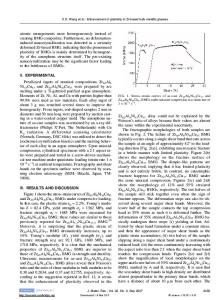Enhanced plasticity in a Ti-based bulk metallic glass-forming alloy by in situ formation of a composite microstructure
- PDF / 195,103 Bytes
- 4 Pages / 612 x 792 pts (letter) Page_size
- 6 Downloads / 299 Views
A bulk metallic glass-forming Ti–Cu–Ni–Sn alloy with in situ formed composite microstructure prepared by both centrifugal and injection casting presents more than 6% plastic strain under compressive stress at room temperature. The in situ formed composite contains dendritic hexagonal-close-packed-Ti solid solution precipitates and a few Ti3Sn, –(Cu,Sn) grains dispersed in a glassy matrix. The composite microstructure can avoid the development of the highly localized shear bands typical for the room-temperature deformation of monolithic glasses. Instead, highly developed shear bands with evident protuberance are observed, resulting in significant yielding and homogeneous plastic deformation over the entire sample.
Bulk metallic glasses (BMGs) have been progressively developed in the past decade. Since they usually have high strength, high hardness, good wear resistance, and excellent corrosion resistance, they are considered to have many potential applications as advanced engineering materials.1,2 However, BMGs exhibit inhomogeneous deformation behavior for temperatures below the glass transition temperature.3 All the plastic flow is concentrated in one or several shear bands. More deformation leads to a softening in the localized bands, with the result that the final fracture occurs along the planes of the softened shear bands. This inhomogeneous deformation, so-called “work softening,” unfortunately leads to catastrophic failure with little plastic elongation in an apparently brittle manner. To prevent inhomogeneous deformation, three methods have been introduced so far, particle reinforcement (adding particles into the alloy during processing4,5 and in situ formed particles6), fiber reinforcement (continuous fibers7–9 and random short fibers10), and in situ formed ductile phase precipitates.11–13 The latter method can significantly enhance the roomtemperature ductility of BMGs by introducing the ductile phase, which usually has a –Ti-type cubic structure and dendritic morphology. So far, most of the efforts for reinforcements were focused on Zr-based BMGs because these alloys have a high glass-forming ability. The elastic strain is about 2–3% for single-phase Zr-based BMGs at room temperature, and the macroscopic plastic strain is almost zero prior to failure.14 After introducing the ductile dendritic –Ti-type phase, the plastic strain can reach
a)
e-mail: [email protected] J. Mater. Res., Vol. 17, No. 12, Dec 2002
6–7% in compression and about 3% in tension for Zr– Nb–Ti–Cu–Ni–Be.11,12 Recently, a 16% compression plastic strain was obtained in a Zr–Ni–Cu–Al–Ta alloy.15 In this work, we present the first successful synthesis of an in situ formed Ti-based BMG composite containing ductile precipitates. The composite microstructure includes mainly a dendritic hexagonal-close-packed (hcp) Ti solid solution, a small amount of intermetallic Ti3Sn, and –(Cu,Sn) dispersed in the glassy matrix. This composite microstructure can avoid the development of the highly localized shear bands under load. Accordingly, defo
Data Loading...











